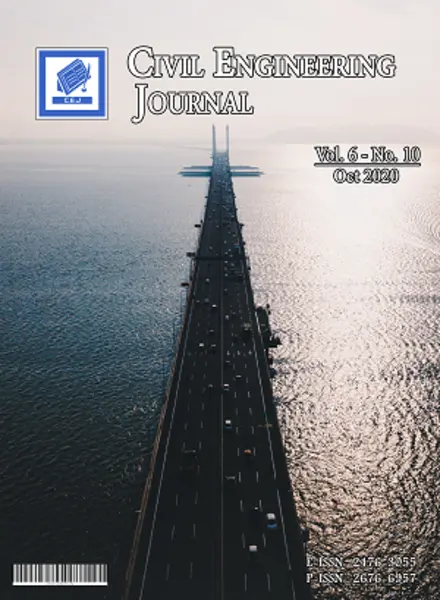-
effect of fibrous jacket on behavior of rc columns
جزئیات بیشتر مقاله- تاریخ ارائه: 1401/11/27
- تاریخ انتشار در تی پی بین: 1401/11/30
- تعداد بازدید: 155
- تعداد پرسش و پاسخ ها: 0
- شماره تماس ژورنال: 982188779475ext.258
effect of fibrous jacket on behavior of rc columns
this paper presented an extensive study about the strengthening of rc square short columns with high strength concrete jackets reinforced with steel fiber. the aim of this study is to investigate the effect of confinement by fibrous jacket on the behavior of rc column. a comparative study is performed on 23 square columns (six of them were unconfined columns where the remaining seventeen were confined columns) with varied parameters such as steel fibers ratio and type, jacket thickness, partial and full strengthening, type of confining jacket (hoop and composite), use of epoxy as bond material between the concrete column and strengthening jacket, and length parameter.
the test results showed that the strengthened columns showed a significant improvement in the ultimate stress, load-carrying capacity, maximum strain, ductility, and energy absorption. increase the steel fibers ratio (1, 1.5 and 2%) increased the ultimate stress by (22.5, 12.3 and 12.5%) respectively.
the use of epoxy as bond material enhanced the ultimate stress by an average improvement by (55%). composite case in the strengthening enhanced the load-carrying capacity larger than hoop case by (28.7 and 42%) for frc jackets with hooked and straight fibers respectively but in case of stress capacity, hoop jacket carries stresses more than composite according to the stressed cross-sectional area. increase jacket thickness (25 and 35 mm) enhanced the ultimate stress by (28.7 and 15.5%) respectively.
partial strengthening has a good enhancement in the ultimate load but was less than full strengthening. increase the length by (25 cm) decreased the enhancement in load capacity of the column with hoop jacket by (45.3%). concrete jackets enhanced energy absorption and ductility which improved the deformation capacity. the compressive behavior of stub concrete columns was also modeled, simulated, and analyzed numerically by a 3d nonlinear finite element model. the verification process was performed against the reported data of the experimental test which proved the results of experimental results and showed a good agreement between experimental and numerical outcomes.
حوزه های تحت پوشش ژورنال
مقالات جدیدترین رویدادها
-
استفاده از تحلیل اهمیت-عملکرد در ارائه الگوی مدیریت خلاقیت سازمانی و ارائه راهکار جهت بهبود
-
بررسی تاثیر ارزش وجوه نقد مازاد بر ساختار سرمایه شرکت های پذیرفته شده در بورس اوراق بهادار تهران
-
بررسی تأثیر سطح افشای ریسک بر قرارداد بدهی شرکت های پذیرفته شده در بورس اوراق بهادار تهران
-
بررسی تأثیر رتبه بندی اعتباری مبتنی بر مدل امتیاز بازار نوظهور بر نقد شوندگی سهام با تأکید بر خصوصی سازی شرکت ها
-
تأثیر آمیخته بازاریابی پوشاک ایرانی بر تصویر ذهنی مشتری پوشاک ایرانی (هاکوپیان)
-
بهسازی موضعی تیر و ستون در سازه های بتنی توسط ورقه های frp
-
تحلیل شبکه های شطرنجی با استفاده از نرم افزار شبیه سازی
-
thermal tests of the 9fb gas turbine unit produced by general electric
-
three-dimensionally ordered macroporous srfeo3−δ with high surface area: active catalysts for the complete oxidation of toluene
-
effect of blending diesel fuel with produced biodiesel using a nanocatalyst on the combustion behavior and emission profile of a diesel engine
مقالات جدیدترین ژورنال ها
-
مدیریت و بررسی افسردگی دانش آموزان دختر مقطع متوسطه دوم در دروان کرونا در شهرستان دزفول
-
مدیریت و بررسی خرد سیاسی در اندیشه ی فردوسی در ادب ایران
-
واکاوی و مدیریت توصیفی قلمدان(جاکلیدی)ضریح در موزه آستان قدس رضوی
-
بررسی تاثیر خلاقیت، دانش و انگیزه کارکنان بر پیشنهادات نوآورانه کارکنان ( مورد مطالعه: هتل های 3 و 4 ستاره استان کرمان)
-
بررسی تاثیر کیفیت سیستم های اطلاعاتی بر تصمیم گیری موفق در شرکتهای تولیدی استان اصفهان (مورد مطالعه: مدیران شرکتهای تولیدی استان اصفهان)
-
بررسی تاثیر سطح سواد والدین بر یادگیری دانش اموزان ابتدایی شهر ایلام
-
تأثیر محرک های مشتری و هزینه بر مدیریت زنجیره تأمین سبز و عملکرد محیطی شرکت های فعال در صنعت فولاد استان گیلان
-
بررسی تاثیر هویت برند بر عملکرد کسب و کار از طریق نقش میانجی اعتماد به برند
-
مقایسه ی هوش معنوی و خودانضباطی پرستاران زن و مرد در بخش های ویژه و عمومی بیمارستان های شهر تهران
-
infill architecture as a solution for livability and historical texture quality promotion


سوال خود را در مورد این مقاله مطرح نمایید :